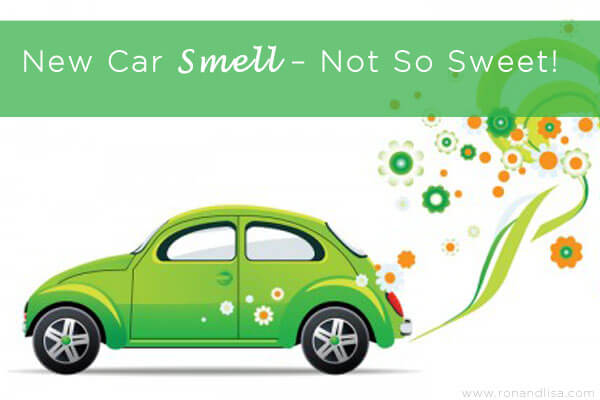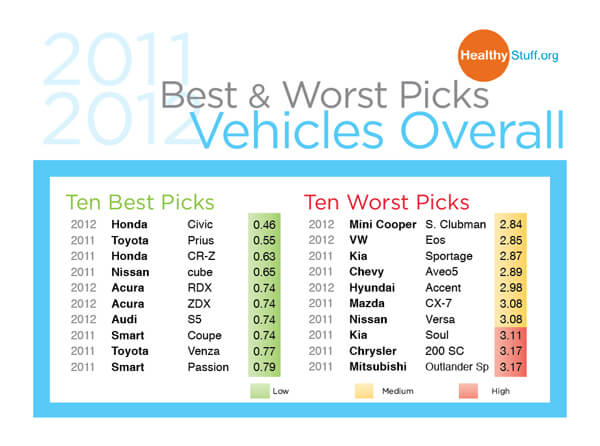Let’s face it, the majority of us have been guilty of committing a vehicle violation, albeit not admittedly to the face of an officer. However, I am not referring to accelerating in access of the speed limit, running through a stop sign or even crossing a double yellow. Rather, I am alluding to the fact that many of us have grown somewhat fond of the intoxicating new car smell that is screams from the interior rooftop of every new automobile. The term intoxicating possesses a split personality of sorts when it comes to the pleasant association of a new car scent. It is something we should be very wary of inhaling, particularly since most of us spend a vast amount of time in our vehicles. According to recent data, the average person spends 1.5 hours in a car per day. And, that’s just the average. This doesn’t take into account those who commute long distances or the Lincoln Lawyer-types who basically work out of their cars.
You may not realize that time spent in your car may be wreaking havoc on your health, especially if the vehicle is newly manufactured and only a few months off the lot. In fact, hundreds of toxic chemicals can be found in auto interiors and are ubiquitous. Chemicals are found in the steering wheel to the arm rest to even your seatbelt. The reason is that many of the synthetic materials and plastics found in the interior of automobiles contain plasticizers, stabilizers, flame retardants, antimicrobials and antioxidants. These additives in the plastics are creating a plethora of indoor air pollutants such as benzene, toluene and xylene in levels exceeding normal indoor and outdoor air quality standards. The off gassing of these materials, often recognized as the term new car smell, can be extremely harmful to human health.
Additionally, indoor air quality in automobile interiors is often exasperated because automobiles are commonly subjected to extreme temperatures (i.e. air temperature up to 192 F / dashboard temperatures up to 248 F). These higher temperatures, in combination with high levels of sunlight, can increase the concentration of Volatile Organic Compounds (VOC’s) that are off-gassing from the car’s plastic interior furnishings creating a toxic indoor cocktail. In fact, the concentrations of brominated flame retardants (BFRs) in vehicles contribute nearly 30% of our total daily exposure.
|
One way to lesson your exposure to interior chemical off-gassing from new cars is to refuse to buy a car that has been sitting on the car lot for less than 6-8 months. Instead, purchase cars that are at least a year or two old, because new cars tend to off-gas pollutants in higher concentrations. Levels of many volatile organic compounds (VOCs) decrease considerably after 6 months. Any car dealer will be able to tell you the date the car was manufactured. When you purchase a car that is a few years old, you actual shortcut the off-gassing process due to the fact that the higher concentration of chemicals off-gassing has already occurred.
Are you currently in the market for a brand new car? The good news is that, today, 17% of new vehicles have PVC-free interiors and 60% are produced without brominated flame retardants in the interiors. This is a drastic improvement from years past and a promising sign for people shopping for a new vehicle. A great resource when researching the purchase of a new, yet healthier automobile is HealthyStuff – a project of The Ecology Center. Not all automobiles are created equal and this organization provides ratings for healthy interiors for hundreds of new vehicles and has screened over 900 vehicles since 2006!
If you would like to speed up the off gassing process of your new vehicle, one thing you can do according to Environment Health of Nova Scotia, is to “bake out” your car. This can be achieved by leaving the car in the hot sun with windows open from 1-2 inches for a several hours (NOTE: no one should occupy the car at this time). Next, follow this up by opening the windows wide to help air out the car completely. Finally, once the airing is complete; clean the interior surfaces with a microfiber cloth and a non-toxic cleaner.
Although cars tend off-gas the highest concentration of chemicals after the first 6-8 months, it is imperative that you don’t compound the problem by introducing synthetic air fresheners and toxic cleaning products to the interior. This would only defeat the purpose since most air fresheners contain toxic phthalates that would compound the issue of poor indoor air quality in your vehicle. Studies have suggested that prolonged exposure to certain kinds of phthalates can cause cancer and developmental/sex-hormone abnormalities.
Related Articles:
Meet Fisker: A New Kind of CARma
The SMARTest Car on the Block!
Unplug & Recharge with the Power of Nature
Climate Change: Fact or Fiction?
PVC: THE POISON PLASTIC! Get Safer Supplies & Back to School Guides
Do You Know What’s Lurking in Your Child’s Classroom?
Green Product Labels 101: How to Read Between the Blurred Lines
4 Sexy & Sustainable-Summer Must Haves for Her
The Incredible Shrinking House: How Small Can You Go?
Eco-Labels & What they Really Mean
Remember, no mandatory testing or regulation of chemicals used inside automobiles exists, therefore, you must be your own judge and trust that your nose knows!
Read an interesting article on The Green Commute.




